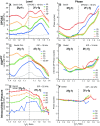Comparing Distortion Product Otoacoustic Emissions to Intracochlear Distortion Products Inferred from a Noninvasive Assay
- PMID: 27229002
- PMCID: PMC4940284
- DOI: 10.1007/s10162-016-0552-1
Comparing Distortion Product Otoacoustic Emissions to Intracochlear Distortion Products Inferred from a Noninvasive Assay
Abstract
The behavior of intracochlear distortion products (iDPs) was inferred by interacting a probe tone (f3) with the iDP of interest to produce a "secondary" distortion product otoacoustic emission termed DPOAE(2ry). Measures of the DPOAE(2ry) were then used to deduce the properties of the iDP. This approach was used in alert rabbits and anesthetized gerbils to compare ear-canal 2f1-f2 and 2f2-f1 DPOAE f2/f1 ratio functions, level/phase (L/P) maps, and interference-response areas (IRAs) to their simultaneously collected DPOAE(2ry) counterparts. These same measures were also collected in a human volunteer to demonstrate similarities with their laboratory animal counterparts and their potential applicability to humans. Results showed that DPOAEs and inferred iDPs evidenced distinct behaviors and properties. That is, DPOAE ratio functions elicited by low-level primaries peaked around an f2/f1 = 1.21 or 1.25, depending on species, while the corresponding inferred iDP ratio functions peaked at f2/f1 ratios of ~1. Additionally, L/P maps showed rapid phase variation with DPOAE frequency (fdp) for the narrow-ratio 2f1-f2 and all 2f2-f1 DPOAEs, while the corresponding DPOAE(2ry) measures evidenced relatively constant phases. Common features of narrow-ratio DPOAE IRAs, such as large enhancements for interference tones (ITs) presented above f2, were not present in DPOAE(2ry) IRAs. Finally, based on prior experiments in gerbils, the behavior of the iDP directly measured in intracochlear pressure was compared to the iDP inferred from the DPOAE(2ry) and found to be similar. Together, these findings are consistent with the notion that under certain conditions, ear-canal DPOAEs provide poor representations of iDPs and thus support a "beamforming" hypothesis. According to this concept, distributed emission components directed toward the ear canal from the f2 and basal to f2 regions can be of differing phases and thus cancel, while these same components directed toward fdp add in phase.
Keywords: DPOAEs; gerbil; human; intracochlear pressure; rabbit.
Figures





References
-
- Cooper NP, Rhode WS. Mechanical responses to two-tone distortion products in the apical and basal turns of the mammalian cochlea. J Neurophysiol. 1997;78:261–270. - PubMed
Publication types
MeSH terms
Grants and funding
LinkOut - more resources
Full Text Sources
Other Literature Sources
Miscellaneous

